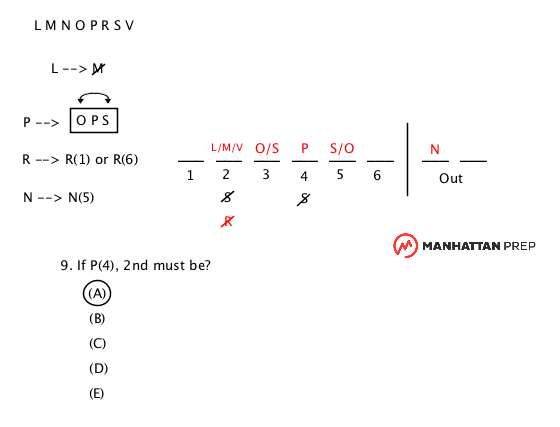
LSAT Forum
3 postsPage 1 of 1
-

- ManhattanPrepLSAT1
-
Thanks Received: 1909
-
Atticus Finch

- Posts: 2851
- Joined: October 07th, 2009
-

- andreperez7
-
Thanks Received: 3
-
Jackie Chiles

- Posts: 45
- Joined: March 11th, 2013
Re: Q9
I doubt that anyone has noticed, but the fact that L and M are twins allows to rule out answers B through E because these answers each have only one of L or M. So without even having to think about the question are drawing anything out, you solve the question in about 5 seconds.
-

- smiller
-
Thanks Received: 73
-
Atticus Finch

- Posts: 205
- Joined: February 01st, 2013
Re: Q9
To make sure that I understand correctly, by "twins" you mean that L and M are equally affected by the first rule and not directly mentioned in any other rule, correct? Just based on the rules, we know that if one of the two is displayed then the other must not be. One or the other must always be out. Other than that, they're basically interchangeable.
What you're suggesting is a very reasonable approach for this particular question, and it's great that you pointed it out. If I was in a hurry, I'd feel pretty comfortable choosing (A) and moving on to the next question. But the process shown in the initial post is a solid way to confirm that choice (A) is correct. And if the test writers wanted to make the question more challenging they might have included L and M in other answers. The approach shown in the initial post--creating a temporary diagram that includes the new condition, adding inferences to the temporary diagram, then evaluating the answers based in the temporary diagram--is an approach that every test taker should be familiar and comfortable with. That's why we usually show it as the default approach to a Conditional Question. But it's always fun and interesting to notice if there's a different way to approach the question!
What you're suggesting is a very reasonable approach for this particular question, and it's great that you pointed it out. If I was in a hurry, I'd feel pretty comfortable choosing (A) and moving on to the next question. But the process shown in the initial post is a solid way to confirm that choice (A) is correct. And if the test writers wanted to make the question more challenging they might have included L and M in other answers. The approach shown in the initial post--creating a temporary diagram that includes the new condition, adding inferences to the temporary diagram, then evaluating the answers based in the temporary diagram--is an approach that every test taker should be familiar and comfortable with. That's why we usually show it as the default approach to a Conditional Question. But it's always fun and interesting to notice if there's a different way to approach the question!
3 posts Page 1 of 1